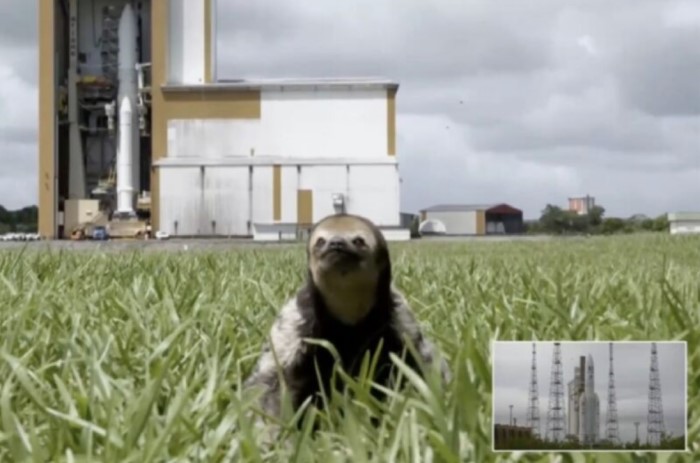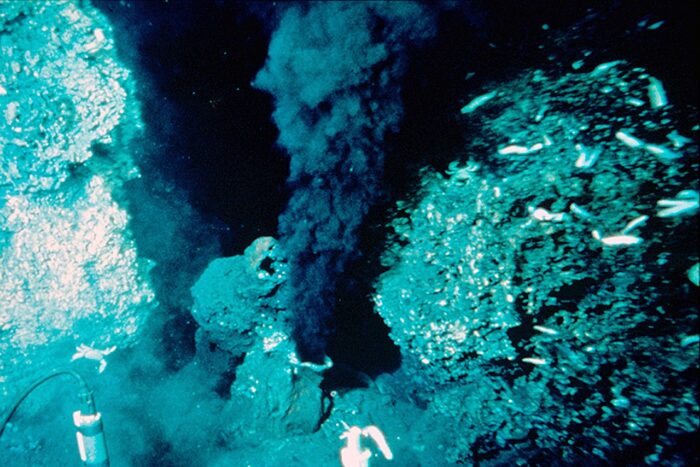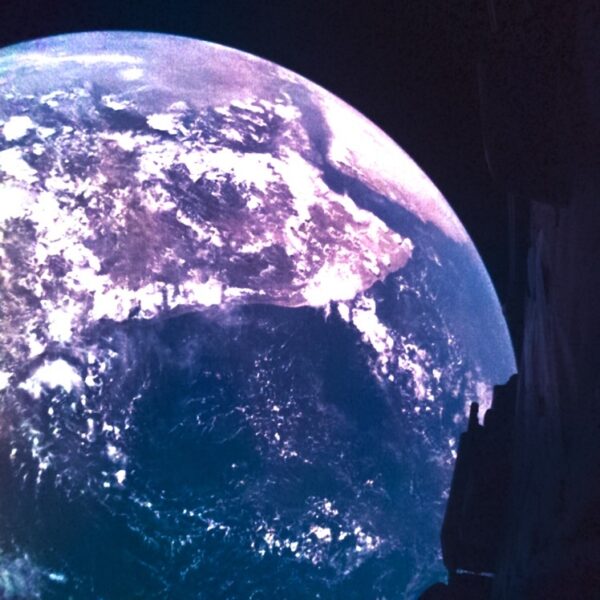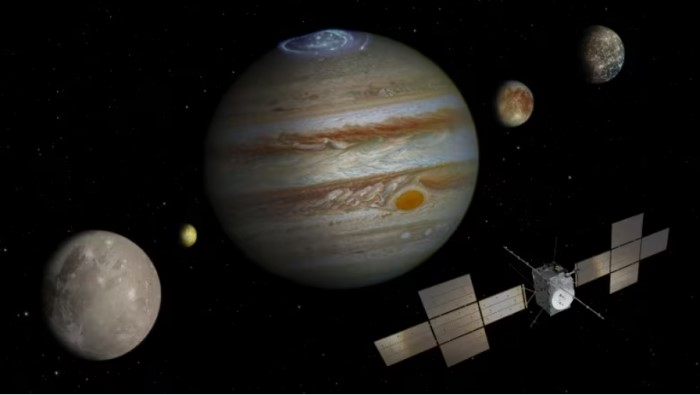Last Friday, April 14, a new probe was launched by the European Space Agency (ESA). The craft was launched on a massive Ariane 5 rocket from Kourou in French Guiana, which is in northern South America.
Space probes get launched all the time, but this one is truly special. Even this photo-bombing sloth was super curious!

"Did the launch happen yet? Am I late?" A sloth waits patiently for JUICE to launch. (European Space Agency)
Why all the fuss?
Because this probe's mission is all about searching for alien life. Right here in our solar system!
The probe is called JUICE, which stands for JUpiter ICy moons Explorer. That name might make its mission sound pretty self explanatory. But what does it actually mean?
We're going to break down everything about the mission for you right here—including why scientists think that the icy moons of the solar system's largest planet are such a good place to hunt for life!
But first ... have a look at JUICE's launch last week!
So many moons!
Depending on who you ask (and what qualifies as being large enough to make the grade), Jupiter has somewhere between 79 and 95 moons.
But not all of those moons are created equal. Though most are extremely small, the four largest are some of the biggest in the solar system. These are the Galilean moons: Io, Callisto, Europa, and Ganymede.
Io, which is almost the same size as our own Moon, is the most geologically active body in the solar system. It has about 400 volcanoes on it and many mountains, some of which are taller than Mt. Everest! That sounds amazing! But it also means that Io is not a good place to find life right now.
Chilled juice

An artist's impression of the vast ocean that may lie beneath the surface of Europa. (NASA/JPL-Caltech)
For that, experts say, we need to look at its three neighbours, Callisto, Europa, and Ganymede. These are Jupiter's 'icy moons', and they are JUICE's target.
Each of these three moons is made of some mixture of rock and ice. And scientists believe that each of them have some kind of subsurface, or underground, ocean. These oceans could contain an immense amount of water. How much?
Even though Europa is slightly smaller than our moon, many researchers believe that its ocean could have more water than there is on Earth! This is because they believe that Europa's ocean is over 100 kilometres (60 miles) deep. Essentially, instead of a crust, it has an ocean!
Its neighbours, Ganymede and Callisto, are similar, though their oceans likely have much more ice. However, Ganymede, which is even larger than the planet Mercury, has its own magnetic field. It could act as protection against the deadly radiation that is generated by the massive Jupiter. (Here on Earth, our own magnetic field is vital protection against radiation from the Sun, making the planet very liveable!)
What kind of life are we talking about?

Underwater vents, like this 'black smoker' are spots where minerals and heats from within the crust bursts into the deep sea. Recent research has proven that they are full of life and may have even been where life first started on Earth. (Wikimedia Commons)
Well, almost certainly not alien fish or squid. Instead, if there is any life on a moon like Europa, it would likely be some kind of bacteria or microbe—tiny life forms that are some of the most basic ones known to science.
That said, it is possible that these alien oceans could host some life forms that are surprisingly complex. The bottom line is that we don't know what is there. Scientists have made guesses based on similar environments here on Earth, like deep sea vents on the ocean floor. These bring heat energy and vital minerals and nutrients from deep within the crust into the water, creating an ideal habitat for worms and crustaceans.
And if it can happen at the bottom of our oceans—a place without any light and under intense pressure—then why not within a world like Europa or Ganymede?
Long term commitment

JUICE's first selfie after its launch. That's us (Earth) in the background! (European Space Agency)
Just talking about this is really quite thrilling. But despite our excitement, we need to be patient and realistic with JUICE and what it can discover.
For one, even though it is loaded with many powerful instruments designed to probe deep under the surface of these moons, it won't be landing on any of these moons. It can only investigate them in detail from a distance and report back what it finds.
In other words, the probe can only give us a clearer picture about what those subsurface oceans are like. It can't actually get inside and provide us with samples of the water and ice itself.
And then there's how long it will take it to get to Jupiter's neighbourhood. JUICE may have been launched last week, but it won't arrive there for another eight years!
Once there, in 2031, it will spend the next four years orbiting Jupiter and the three moons. The mission ends in 2035.
Why the long wait?
JUICE could get to Jupiter much faster. But it would take a tremendous amount of fuel, which weighs a lot. And thanks to all of its instruments, the probe already weighs over 2 tons (around 2,420 kg or 5,340 lbs). And then there's the matter of needing to have some fuel leftover to explore all of those moons once it gets there!
To save as much fuel as possible, JUICE will spend most of the next eight years orbiting around the Sun close by planets like Venus and Earth. Each time it swoops past a planet, it will use that planet's gravity to 'slingshot' it and whip it even faster through space. This is essentially how comets and asteroids zoom their way around!
After enough of these slingshots, it will have enough momentum to carry itself to Jupiter and start the most important part of its mission. It may be a long wait, but we bet it will be worth it!
To learn more about the mission, we recommend watching this great video from the Wall Street Journal. Now that's some juicy news!
 An artist's impression of JUICE orbiting Jupiter with the moons (L-R Ganymede, Io, Europa, and Callisto around the planet. (J. Nichols/University of Leicester/University of Arizona/ATG medialab/NASA/JPL/DLR/ESA)
An artist's impression of JUICE orbiting Jupiter with the moons (L-R Ganymede, Io, Europa, and Callisto around the planet. (J. Nichols/University of Leicester/University of Arizona/ATG medialab/NASA/JPL/DLR/ESA)









